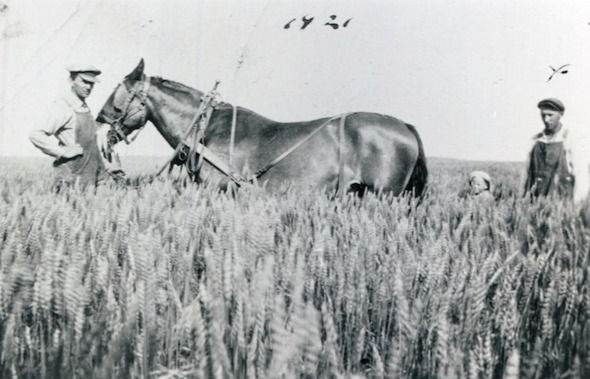- Charlie B

- Apr 8, 2020
- 3 min read
On any prairie farm the nerve centre is the farmhouse. On our Vauxhall farm this was certainly the case. It was a source of warmth and comfort, a feeding station, a laundry, first aide source and above all communication centre. Psychologically it provided a sense of safety and protection against the world's tribulations. We played games and played tricks. For example, I recall that my dog “Spot” would come in from a day-long hunt wet and exhausted. Dad would feed her and put a blanket on the floor behind the big warm stove for her to dry out and sleep. When I was very young I used to take a small piece of meat and creep behind the stove where she was deeply asleep. I would place the treat right in front of her nose and watch her nose begin to twitch, her legs begin to make running movements and finally she would wake up and look around bleary eyed, gulp the morsel and fall back asleep. I always laughed and laughed.

The kitchen was the centre of the Universe. We entered via the rear entrance from the house yard up a short flight of stairs into an anti room which contained a large kerosene-fed refrigerator and many storage shelves and cabinets with drawers, all plugged with supplies. Through an archway we entered the large kitchen with green pattern linoleum on the floor. On the left wall was a huge wood burning Findlay stove with water wells embedded to provide a source of hot water from the its heat. On the right wall was a long dining table which accommodated a dozen people. Straight ahead were counters and a large sink and the food preparation areas. There was a small room in the left corner with a couch which could be used as a bed and the large staticky radio - our entertainment Center and window on the world. At the far end of the kitchen, a passage way led into a circular hall where there was a furnace heated register or grill on the floor in the centre of the circle. Off the hall like spokes of a wheel were three doors leading to bed rooms, the bathroom and an archway into the furnished front sitting room furnished with a couch, overstuffed arm chairs, china cabinet, and nice rug on the floor. The exit through the front door led out onto a small deck and a cropped lawn. There was a mounted deer head with big horns hung at the front door that dad had shot as a teenager. Brother Don used to take this trophy down when my dad wasn’t looking and chase me around the house shrieking. The basement was a wonder. It housed a cream separator, an old Maytag wringer clothes washer, a canning machine and most important the coal burning furnace and the electric gas generator that charged a bank of batteries supplying 12 volt electricity to the house for lights etc. The water storage cistern was built into the wall. There were banks of shelves filled with bottled and canned produce. A large stone container contained an egg preservative called “water glass” which, when the eggs were submerged, kept them fairly fresh and usable for months. The basement was cool and in the heat of the summer meals were eaten in comfort downstairs. A refuge indeed. All in all the house was well planned and functional. In later years I have begun to marvel at how well planned and functional it was which was the case with the whole farm.













